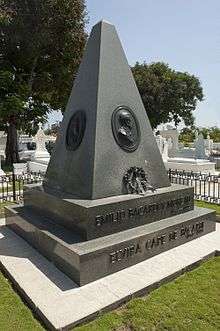Emilio Bacardi
Emilio Bacardi Moreau (1844–1922) was a Cuban industrialist, politician, and writer who managed the Bacardi Rum Company and served as mayor of Santiago.
Biography
Emilio was the son of Facundo Bacardi and his wife Amalia Moreau. His father was a businessman who in 1862 founded the Bacardi distilling company that would grow into today's international corporation. However, before finding stability in the rum business, Facundo and his young family experienced some of tragedies of the day. For instance, in 1852 a major earthquake struck Santiago and the family briefly returned to Spain to escape the ensuing epidemics of cholera (epidemics which claimed some of Emilio's siblings). Upon his return, Facundo found that the general store he had been running was looted and its customers had fled. Within a few years he was bankrupt.
In some ways, Emilio was protected from the turbulence by distance: the family's return to Cuba was completed without him, who stayed behind with a family friend in Spain. He received instruction in literary and political topics and grew to appreciate the arts and the liberal politics of the day (including abolition of slavery, criticism of organized religion, nationalism, and democracy). By the time he returned to Cuba at the age of 17, his interests lay more in political and poetic activism than business. However, as the first-born son of his father, he was given a growing and important role in the fledgling company.
Throughout the 1870s, 80's, and 90's, Emilio's dual identity as business magnate and subversive political activist grew. The rum business continued to grow under his leadership, which was made official in 1877 when Don Facundo retired and named him president of the company. At the same time, Emilio became more and more involved in Cuba's nationalistic resistance to the Spanish Empire. He was repeatedly arrested and imprisoned on suspicion of helping the rebels. These suspicions were well founded, as Emilio used his respectable business activities and connections as a cover for developing a financial network which channelled resources to the rebel guerilla army.[1]
Emilio's personal life continued to develop as well: in 1876 he married Maria Lay Berlucheau, a French Cuban from Santiago. He would go on to have a number of children with her, including Emilio (Emilito), Daniel, Jose, Facundo, Maria, and Carmen. In the spring of 1885, however, she died at the age of 33, devastating Emilio and sending him into a depression from which it took months to recover. His eventual recovery coincided with the companionship of Elvira Cape, whom he married in 1887 and lived with for the rest of his life. Their four children (Marina, Lucia, Adelaida, and Amalia) further enlarged the Bacardi family.

The political fortunes of both Cuba and Emilio were radically altered by the Spanish American War, in which the conquering American army took over administration of the island. The American military governor of Santiago, General Leonard Wood, appointed Bacardi as mayor of Santiago. In this position, Emilio worked extensively with the American military administration, and the relationship between him and General Wood warmed to the level of friendship, tempered by their complicated political relationship.[2] As mayor, he was generally recognized as a competent and effective manager, succeeding on extending services and practicing good government under the military administration and later the new Cuban republic. His reputation for honesty and public service distinguished him from many of the would-be leaders who arose in the post-independence political scramble, and he eventually ran for and won a seat in the national senate in 1906.
References
- ↑ Gjelten, Tom (2008). Bacardi and the Long Fight for Cuba. Viking. pp. 45–67. ISBN 978-0-670-01978-6.
- ↑ Gjelten, Tom (2008). Bacardi and the Long Fight for Cuba. Viking. p. 85. ISBN 978-0-670-01978-6.